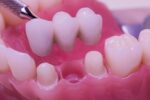Did you know that dental implant procedures have surged by an impressive 15% in the last two years, reflecting a growing trend toward lasting solutions for missing teeth?
Imagine a recovery process that’s not just swift but tailored to fit seamlessly into your life. Ever wondered about the hidden risks of rejection?
Fear not, as Canada boasts a rejection rate below the global average, a testament to cutting-edge research and meticulous care. And what about those potential side effects?
Embark on a seamless recovery after a dental implant, blending advanced science with optimal care for a smile that mirrors the excellence of our captivating journey.
I. Dental Implant Procedures
A. Two-stage Healing Plan:
Dental implants are placed into the jawbone initially as part of a two-stage healing strategy that allows the implant to bond and stabilize. This crucial initial phase fosters stability over the long run.
The surgery is then finished by adding a connector, which joins the implant to the replacement tooth or crown.
This painstaking process puts progressive integration first for a dependable and long-lasting outcome that improves the implant’s appearance and functionality
B. Implant length considerations
An essential factor in customizing the treatment to each patient’s demands is the implant length. Personalized according to the patient’s dental architecture and bone structure, this offers ideal stability and support.
The dentist can build a stable base for the prosthetic teeth with the help of the customized method, which encourages long-term success and a natural appearance.
This commitment to precision not only guarantees a comfortable and useful outcome but also minimizes the potential side effects of dental implants.
C. Biomechanics-based Treatment Strategies
Dental implants are built on biomechanics-based techniques, which guarantee their longevity and natural function.
Their primary objective is to create implants that resemble natural tooth structures and can endure biting forces.
Implant stability is given priority in these procedures by taking into account oral biomechanics. It’s similar to designing a perfectly functional and natural-looking solution that blends in with the changing oral environment.
This method guarantees a beautiful, durable result, giving patients both visual appeal and dependability in their functionality.
II. Dental Implant Recovery
A. Common Post-Surgery Symptoms
Navigating dental implant recovery begins with an understanding of common post-surgery symptoms. It’s normal to experience mild swelling and discomfort, indicative of your body’s natural healing process.
These transient signs reassure you that the transformation toward a stunning smile is underway. Embrace this phase, knowing that discomfort is temporary, paving the way for lasting confidence.
B. Dentist’s Role in Recovery
Your dentist serves as a crucial guide on your recovery journey. In a user-friendly manner, we provide personalized insights to ease discomfort and ensure a smooth healing process.
With their expertise, your recovery becomes more than a procedure—it’s a partnership. Trust in their support, making your transition to a revitalized smile a reassuring and informed experience.
C. Follow-Up Care and Checkups
The commitment to follow-up care and checkups is the cornerstone of a seamless recovery.
These appointments are not just routine; they are checkpoints tailored to monitor your progress, address concerns promptly, and refine your recovery plan.
Your active collaboration in this process ensures that every visit brings you closer to a confident and vibrant smile, guided by our dentist near you.
III. Dental Implant Rejection
Causes of Rejection
- Titanium Allergy: Some individuals may experience rejection due to an allergy to titanium, a common implant material.
- Bacterial Infection: Infection during or after the implant procedure can lead to rejection, affecting the implant’s integration with the jawbone.
Types of Rejection
- Early implant rejection: This occurs shortly after the procedure, often due to surgical complications or immediate complications.
- Late Implant Rejection: This develops over time and is often linked to factors like poor oral hygiene or untreated infections.
The Importance of Consulting an Experienced Specialist
Seeking guidance from an experienced specialist is crucial to navigating potential rejection issues.
Our experienced professionals can assess risk factors, ensure proper material compatibility, and address concerns promptly.
This ensures a personalized and attentive approach, minimizing the risk of rejection and promoting successful dental implant outcomes.
IV. Possible Side Effects of Dental Implant Surgery
-
Pain:
After implant surgery, some discomfort is common and is typically treated with prescribed painkillers.
Accurate comfort modifications are ensured when patients communicate their level of pain to the dental team.
-
Bleeding:
Some minor bleeding may happen at first, but it should stop. For optimal clotting, use the supplied cotton with mild pressure and refrain from forceful rinsing.
-
Swelling:
Swelling is a normal side effect that usually peaks in the first 48 hours of treatment.
Using ice packs regularly on the first day after surgery reduces swelling and improves comfort.
-
Bruising:
While bruising at the surgery site is possible, take comfort in the fact that it’s a typical part of the recovery process.
Although it tends to fade quickly, understanding that bruising is a temporary stage in your journey reassures you on the path to a renewed smile.
-
The Significance of Adhering to Post-Operative Instructions:
Your journey to a speedy recovery hinges on following post-operative recommendations diligently.
From dental hygiene to dietary regimens and prescription drugs, adherence to these guidelines ensures optimal healing, minimizes discomfort, and cultivates positive dental implant outcomes.
For optimal dental implants near you, adhere attentively to post-operative instructions, ensuring a smooth recovery and lasting success.
Nurturing Your Smile’s Future
We take a look at the rise in dental implant surgeries, recovery strategies, and possible side effects in an environment of future dentistry excellence.
We place your natural comfort and visual appeal first, from the detailed two-stage recovery plan to biomechanics-based techniques.
Skilled practitioners provide tailored care, detailing rejection causes, recovery symptoms, and the dentist’s critical role.
Schedule an appointment at Sidney Harbour Dental so that you can effortlessly adjust to a bright and self-assured smile.









